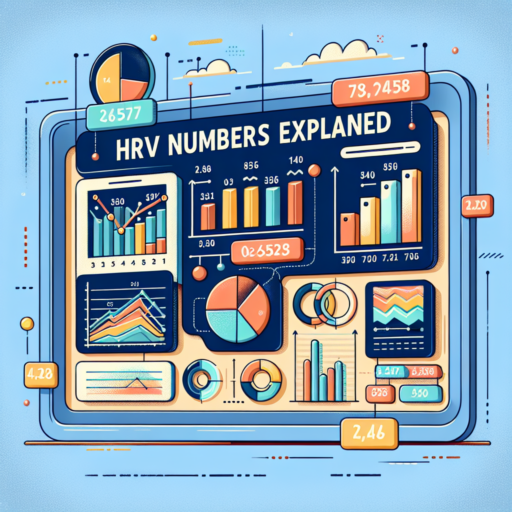What is a good HRV number?
Understanding the concept of a good HRV (Heart Rate Variability) number is crucial for assessing overall wellness and physical fitness. HRV measures the variation in time between each heartbeat, signifying the heart’s ability to adapt to varying stress levels, physical demands, and environmental changes. Generally, a higher HRV indicates a healthier, more resilient heart, capable of efficiently managing stress, whereas a lower HRV is often associated with stress, fatigue, or potential health issues.
Factors Influencing HRV Numbers
Several factors can influence your HRV number, including age, fitness level, lifestyle choices, and stress levels. Typically, younger, fitter individuals tend to have higher HRV numbers due to their healthier cardiovascular systems. Lifestyle choices such as diet, exercise, and sleep quality also play significant roles in improving or diminishing HRV scores.
Interpreting Your HRV Scores
When interpreting HRV scores, it’s essential to consider personal baseline levels. A «good» HRV for one person might be lower or higher for another, making it critical to always compare against your own averages rather than standardized values. Generally, an HRV above 60 ms (milliseconds) is considered good for adults, indicating a strong, responsive cardiovascular system. However, regular monitoring and comparison against personal baselines will provide the most accurate assessment of individual heart health and stress management capabilities.
No se han encontrado productos.
Is 30ms a good heart rate variability?
When discussing heart rate variability (HRV), it’s important to understand that it refers to the variation in time between each heartbeat. A common question arises: Is 30ms a good heart rate variability? This metric can vary significantly among individuals, influenced by factors such as age, fitness level, and overall health.
Firstly, a HRV of 30 milliseconds (ms) might seem low when compared to the wide range typically observed in healthy adults, which can span from 20ms to 200ms. However, it’s critical to consider personal health context and physical condition. For athletes and young adults, higher HRV figures are often noted, indicating better autonomic nervous system balance and cardiovascular fitness. Conversely, lower HRV can suggest stress, poor heart health, or even overtraining in some cases.
Understanding your baseline HRV and how it fluctuates over time is essential rather than focusing solely on a single measurement. Changes in your lifestyle, such as improvements in diet, exercise, and stress management, can lead to significant variations in your HRV. Therefore, a 30ms HRV could be a starting point for someone embarking on a journey to better heart health.
It’s advisable to consult with a healthcare professional to interpret HRV scores accurately within the context of your overall health profile. While a 30ms HRV may signal the need for lifestyle adjustments for some, it could also fall within a normal range for others, particularly when considering factors like genetic predisposition and existing health conditions.
What is a good HRV during sleep?
Understanding what constitutes a good Heart Rate Variability (HRV) during sleep is crucial for assessing overall well-being and sleep quality. HRV measures the variation in time between each heartbeat, which is directly linked to the body’s autonomic nervous system and its ability to manage stress, restore, and repair.
During sleep, a higher HRV is generally considered beneficial as it indicates a relaxed, restorative state and a resilient stress-response system. Specifically, an HRV above 75 milliseconds (ms) for adults is often regarded as a good indicator of healthy heart function and stress recovery. However, it’s important to note that HRV can be highly individualistic and influenced by a variety of factors including age, genetic predisposition, and overall fitness level.
Factors Influencing HRV During Sleep
- Physical Activity: Regular, moderate exercise can improve HRV by enhancing heart health and stress resilience.
- Stress and Relaxation: High stress levels can reduce HRV, whereas relaxation techniques such as meditation can improve it.
- Sleep Quality: Consistent, high-quality sleep supports higher HRV, indicating effective rest and recovery processes.
Understanding your own HRV through wearable technology can provide valuable insights into your health and guide decisions to optimize sleep, reduce stress, and improve overall well-being.
How to interpret HRV results?
Interpreting Heart Rate Variability (HRV) results can initially seem complex, but with a basic understanding of what HRV measures, it becomes significantly simpler. HRV refers to the variation in the time interval between heartbeats, and is considered a reliable marker of the autonomic nervous system (ANS) activity and balance. Higher HRV values generally indicate a strong and adaptable nervous system, while lower values may suggest stress, fatigue, or underlying health issues.
Understanding Your HRV Score: Typically, HRV scores are expressed as milliseconds (ms) of variation between heartbeats. A healthy range may vary widely between individuals, making it important to compare your results against your own baseline rather than standard norms. Factors such as age, fitness level, and lifestyle choices (e.g., smoking, alcohol consumption) can significantly influence your HRV. Observing changes over time can provide insight into how your body responds to stress, recovery, and overall health.
Key Metrics to Watch
- Baseline HRV: Your average HRV when at rest. Establishing a personal baseline is crucial for meaningful comparisons over time.
- Stress Levels: An increased HRV can indicate a relaxed state, whereas a decreased HRV may signal stress or overtraining.
- Recovery Rate: The speed at which your HRV returns to baseline after physical or emotional stress can inform your recovery status.
While interpreting HRV results can aid in assessing overall wellness and stress management, it’s essential to consider these results as part of a broader context of health metrics and personal factors. Regular monitoring and consultation with healthcare professionals can enhance interpretation accuracy, ensuring that HRV tracking effectively contributes to health and performance goals.




